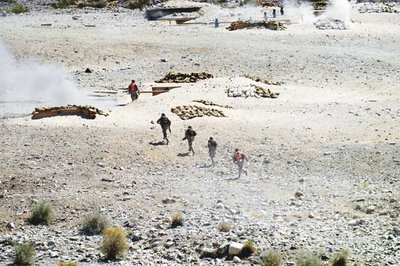
By Pfc. Nathaniel Sapp USMC
Combat Corresponndent
After a short night of sleep on the rocky terrain at Range 410A here, Marines from A, C and D Companies, 2nd Light Armored Reconnaissance Battalion, 2nd Marine Division, awoke early June 22 and took the Squad Hasty Attack Course head-on as part of their Mojave Viper pre-deployment training.
The live-fire course consists of three bunkers and forces the Marines to employ basic and advanced skills they've learned.
“Essentially what we did there is pretty much the foundation of what the Marine Corps is made of,” said Staff Sgt. Scott P. Rixmann, a Cheyenne, Wyo., native and acting company gunnery sergeant for Company D.
“This course allowed us to not only perform the same function as any other infantry unit, but also use the strength of our vehicle's weapons for a longer period of suppressive fire,” he added. The vehicles' weapons consist of 25 mm chain-gun and a 7.62 mm machine-gun.
The Marines take advantage of this type of training due to the positive impact it has on the entire team, as well as the reinforcement of basic skills.
“Mainly this type of training can be used as a confidence builder for shooting on the move, formations and movement and most importantly, unit cohesion,” said Sgt. Johnny W. Benson, an Oakman, Ala., native and squad leader for 2nd Platoon, Delta Company.
“We started training for this range way before we even came out here,” He said. “When we got out here we did two range-walks, one dry-run [a run with blank rounds], and finally the live-fire.”
Much like how a band practices their songs individually, the Marines practice single elements until they know them by heart, before they put on their “show.”
“We aren't able to do training like this on such a large scale back in [Camp Lejeune] because we don't have the facilities there,” he added. “Instead we just break it down into little parts and tackle those.”
It's because full-scale training like this that these Marines are able to deal with the heat and other rough conditions.
“What made it worth it was watching and working with my Marines, seeing them come into their billets and lead,” Benson said.”
Overall, the course went well with the Marines meeting and exceeding expectations.
“I expect my Marines to be genuine, to accomplish the tasks set out to them and to perform as a team,” said Rixmann. “Ultimately I saw all of that during the training.”
"
No comments:
Post a Comment